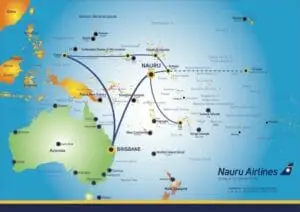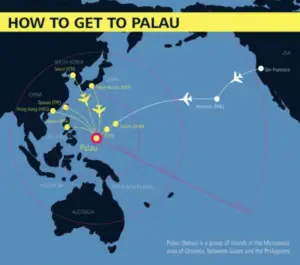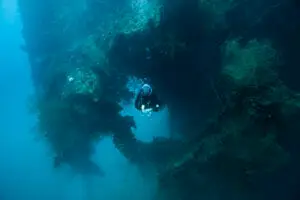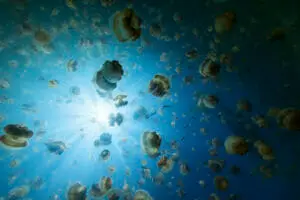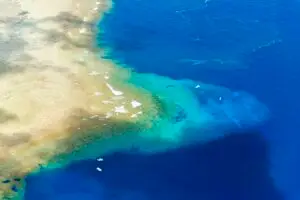Tucked between Koror and Peleliu in the heart of Micronesia, the Rock Islands, known locally as Chelbacheb, are unlike anywhere else on Earth.
Picture this: hundreds of green, forest-topped limestone domes rising from a turquoise lagoon, their bases sculpted over millennia into surreal mushroom shapes.
But these islands are more than a backdrop—they’re a living ecosystem, a cultural archive, and a global model for marine conservation.
Designated a UNESCO World Heritage Site in 2012, the Rock Islands Southern Lagoon includes over 400 uninhabited islets, 50+ marine lakes, and some of the most biodiverse coral reefs on the planet.
Whether you’re snorkeling with golden jellyfish, drifting through shark-filled channels, or paddling through hidden mangrove tunnels, this is a place that invites discovery and demands respect
“No matter how many times I paddle here, I still find something new—an archway, a jellyfish bloom, a nesting bird I’ve never seen before.”
In this guide, built from our firsthand experiences, local expert interviews, and insights from Palau Dive Adventures’ dive logs, we’ll explore the Rock Islands in depth.
You’ll find:
- The story of how these mushroom-shaped islets were formed
- Wildlife highlights, from dugongs to jellyfish
- Scuba dive and snorkeling site breakdowns
- Planning tips, conservation rules, and the Palau Pledge
Whether you’re a diver, a snorkeler, a kayaker, or a nature lover, this is your full-access pass to one of Earth’s last untouched marine sanctuaries.
What & Where: The Geography of the Rock Islands
Palau’s Rock Islands, also known as Chelbacheb, form a vast marine maze of 445 limestone islets, protected within the Southern Lagoon between Koror (Palau’s main town) and Peleliu.
While most sources reference 250–300 islands, UNESCO’s official listing includes every islet, reef knob, and limestone outcrop, making this one of the most geologically and biologically diverse seascapes in the Pacific.
The total land area is surprisingly compact—just 40 to 45 square kilometers—but the islands are spread across a 1,000 square kilometer lagoon, creating a sprawling natural amphitheater for exploration.
Some rise dramatically up to 207 meters (679 feet) above sea level, their bases narrowed over centuries by erosion and bioactivity, forming the famous “mushroom” shapes seen in aerial photos.
“From a kayak, it’s easy to forget where you are—until you spot the sheer cliffs of Ngeruktabel looming above the mangroves.”
How the Islands Are Grouped
To help visitors and guides navigate this aquatic labyrinth, the Rock Islands are typically divided into the following key clusters:
- Ulebsechel Islands (Northeast)
Closest to Koror, often the launch point for day tours. - Urukthapel Islands (Southwest of Ulebsechel)
Includes Ngeruktabel, the largest Rock Island (~47 km²). - Ulong Islands (West)
Known for its pristine beaches, ancient cave paintings, and drift diving at Ulong Channel. - Mecherchar Islands (Southeast)
Home to Eil Malk, where the famous Jellyfish Lake is found. - Smaller sub-clusters:
- Seventy Islands (ecologically restricted, no visitor access)
- Ngemelis Islands, near Blue Corner & other elite dive sites
- Seventy Islands (ecologically restricted, no visitor access)
Ngeroi Islands, closer to Peleliu
These islands are uninhabited and protected by law. There are no hotels, no restaurants, and no settlements. What you’ll find instead is a wild, unspoiled seascape where marine lakes, caves, limestone forests, and hidden beaches unfold with every turn of the tide.
This natural geography sets the stage for everything that makes the Rock Islands so unique, from rare jellyfish species to high-adrenaline drift dives.
Whether you’re scanning maps or gliding silently through the lagoon, understanding the layout is your first step to unlocking the magic of this UNESCO-listed wonder.
These islands are uninhabited and protected by law. There are no hotels, no restaurants, and no settlements. What you’ll find instead is a wild, unspoiled seascape where marine lakes, caves, limestone forests, and hidden beaches unfold with every turn of the tide.
This natural geography sets the stage for everything that makes the Rock Islands so unique, from rare jellyfish species to high-adrenaline drift dives.
Whether you’re scanning maps or gliding silently through the lagoon, understanding the layout is your first step to unlocking the magic of this UNESCO-listed wonder.
Quick Facts & Key Highlights of the Rock Islands
📍 Location & Island Count
Located in Palau’s Southern Lagoon, between Koror and Peleliu.
Comprises approximately 250–300 limestone islets, with UNESCO counting 445 total islets, knobs, and reef outcrops.
Urukthapel (Ngeruktabel) is the largest, covering about 47 km² .
🏝️ Island Groups
Major clusters include:
Ulebsechel (northeast, nearest Koror)
Urukthapel (southwest, includes Urukthapel)
Ulong (west, known for beaches and cave art)
Mecherchar (southeast, including Eil Malk with Jellyfish Lake)
Smaller groups: Seventy Islands, Ngemelis, and Ngeroi.
🌋 Geology & Shape
Carved from coral limestone atop ancient volcanic ridges.
Natural erosion and marine bioactivity sculpted the iconic mushroom-shaped islands.
Most rise up to 207 m (679 ft) above sea level.
🐠 Marine Lakes & Dive Sites
Contains 52 marine lakes, including the world-famous Jellyfish Lake with stingless golden jellyfish.
Hosts top dive spots like Blue Corner, Blue Holes, and German Channel, as well as snorkeling in Jellyfish Lake.
🏆 UNESCO World Heritage
Inscribed in 2012 as one of just 32 “mixed natural and cultural” sites globally, and the only one in the South Pacific.
🌳 Ecosystem & Biodiversity
Contains bare limestone forests (no soil) supporting two endemic palm species.
Protected zones include mangrove nurseries, caves with 4,000-year-old pictographs, and habitats for the endangered dugong.
Nature’s Architecture – How the Islands Formed
At first glance, the Rock Islands look like they’ve been sculpted by design—green-topped domes with narrow limestone bases rising from turquoise water.
But these surreal “mushroom-shaped” islets are the result of millions of years of natural transformation, combining tectonic movement, sea-level shifts, erosion, and marine biology.
“From the boat, you can see the island bases curve inward like an hourglass. It’s wild—those undercuts were carved by waves and urchins over centuries.”
The distinctive mushroom profile comes from constant bio-erosion at the waterline. Wave action wears away the limestone’s base, and organisms like sponges, chitons, snails, and sea urchins actively graze the rock, hollowing out the lower edges.
The upper portions remain intact, topped by the forest canopy, creating the famous silhouette. What’s equally impressive is that these islands support dense jungle with no real soil.
Instead, humus a layer of decomposing plant matter, accumulates in limestone crevices, giving plants just enough nutrition to take root.
Some of these forests host two species of palm trees found nowhere else on Earth, thriving entirely on rock and rain.
This rare convergence of coral geology, marine biology, and tropical botany has made the Rock Islands a subject of fascination for scientists and nature lovers alike. Their unique shape isn’t just visually stunning—it’s a living example of how oceanic forces, climate, and life forms have shaped the Pacific over thousands of years.
Marine Lakes & Evolutionary Oddities
If the Rock Islands are nature’s sculptures, then their marine lakes are Palau’s hidden evolutionary laboratories, ancient, isolated, and unlike anywhere else on Earth.
Scattered across the interiors of the limestone islands are more than 50 saltwater marine lakes—the highest concentration in the world.
These lakes were once connected to the ocean, but over thousands of years, uplift and erosion sealed them off, creating isolated aquatic ecosystems where species evolved in near-total seclusion.
The most famous of these is Jellyfish Lake (Ongeim’l Tketau) on Eil Malk Island. Every morning, millions of golden jellyfish rise and drift across the water in a gentle sun-following migration.
Over time, and in the absence of predators, they’ve lost the ability to sting. Instead, they survive through a delicate symbiosis with algae that live inside their tissues, glowing gold in the sunlight as they pulse across the lake’s surface.
“These jellies won’t sting you—but your sunscreen can harm them. Go in clean, go in calm, and just enjoy the silence. That’s the magic of this place.”
Visiting Jellyfish Lake Responsibly (Even When the Jellyfish Are Gone for now)
Jellyfish Lake is currently open to visitors, but the golden jellyfish that made it famous are not present in significant numbers.
Due to natural environmental shifts like El Niño, the jellyfish population periodically crashes.
Right now, the lake remains an ecological wonder, but be aware: there may be few or no golden jellyfish during your visit.
That said, the rules remain in place to protect this fragile marine lake and support its long-term recovery.
What You Need to Know Before You Visit:
🛑 Scuba diving is strictly prohibited.
Below 15 meters, the lake contains toxic hydrogen sulfide, which is lethal if inhaled or absorbed through the skin. Bubbles from scuba tanks can also damage the lake’s unique chemistry and wildlife.
🥽 Snorkeling is allowed—but only at the surface.
You are not permitted to dive below or free-dive near the chemocline (layer of separation between oxygenated and toxic water).
🧴 No regular sunscreen allowed.
Only marine-safe, non-toxic sunscreen may be used—and it must be applied before arriving. Better yet, wear a rash guard or dive skin to avoid chemicals altogether.
🎟️ Permits are required.
You’ll need the Rock Islands + Jellyfish Lake Permit, which costs ~$100 USD per person and is valid for 5 days.
Proceeds go toward:
- Conservation programs
- Research on lake biology and recovery
- Ranger patrols and education outreach
Why the Rock Islands Are a UNESCO World Heritage Site
In 2012, Palau’s Rock Islands Southern Lagoon was officially inscribed as a UNESCO World Heritage Site, recognized not only for its spectacular landscapes but also for its ecological significance and cultural heritage. At the time, it was one of only 32 sites globally awarded “mixed heritage” status and the only one in the Pacific Islands.
“It’s rare for a place to qualify for both natural and cultural value,” explains Lara, a Palauan conservation officer. “But here, coral reefs, jellyfish lakes, and ancient human settlements all exist within one protected lagoon.”
🌿 Four Reasons UNESCO Recognized the Rock Islands
1. Exceptional Natural Beauty
A surreal seascape of mushroom-shaped limestone islands scattered across turquoise waters. It’s a natural wonder that looks untouched by time.
2. Biodiversity Hotspot
The Rock Islands host:
- Over 385 species of coral
- 13+ species of sharks
- Endangered species like the dugong, hawksbill turtle, and Palau megapode
- Two endemic palm species found nowhere else on Earth
- Rare marine lakes with jellyfish found only in Palau
3. Unique Ecological & Biological Processes
From coral reef development to evolution in marine lakes, this area shows how ecosystems adapt, thrive, and evolve in isolation. Jellyfish Lake and Clear Lake are case studies in rapid species divergence.
4. Cultural Significance
The islands contain stone ruins, burial caves, and 3,000–4,000-year-old pictographs. Once home to seasonal Palauan villages, these islands reflect ancient traditions of land use, navigation, and spiritual connection to nature.
Conservation in Action: What Visitors Need to Know
The UNESCO listing doesn’t just celebrate Palau—it protects it. The Southern Lagoon is governed by conservation laws that prohibit:
- Permanent development or settlement
- Unsustainable fishing
- Unregulated tourism
To help preserve this delicate environment, every visitor contributes through permits and fees:
- Rock Islands + Jellyfish Lake Permit: ~$100 USD
- Environmental “Green Fee”: Included in airfare
- Additional Peleliu State Fees may apply for specific zones
Funds go toward:
- Marine patrols and enforcement
- Reef and lake health monitoring
- Cultural site preservation
- Local education and sustainable tourism development
“When you visit Palau, you’re not just a tourist—you’re a partner in conservation,” says Arsenio, a local ranger.
What This Means for You as a Traveler
Visiting the Rock Islands is a privilege with responsibility. You’re entering a world that’s still wild, sacred, and scientifically significant.
- Stay on marked paths
- Don’t touch corals or cave walls
- Use reef-safe products
- Follow your guide’s instructions
- Take only photos, leave only gratitude
UNESCO didn’t protect the Rock Islands because they’re beautiful—they did it because they’re irreplaceable.
As a guest here, your respectful visit helps ensure that Palau’s lagoon, reefs, and cultural sites remain intact for future generations to study, protect, and experience.
Wildlife of the Rock Islands: What You’ll See Above & Below the Surface
Palau’s Rock Islands are not just stunning to look at they’re alive with biodiversity.
Designated part of the Coral Triangle and protected as a UNESCO World Heritage Site, this region supports some of the richest marine and terrestrial wildlife in the Pacific.
🐠 Beneath the Surface: Coral Reefs, Sharks & Rays
The reefs surrounding the Rock Islands are home to:
- 385+ species of hard coral
- Reef sharks: including grey reef, blacktip, and whitetip species—many of which are protected under Palau’s pioneering Shark Sanctuary.
- Green and hawksbill sea turtles
- Manta rays, especially near German Channel
- Giant clams, moray eels, sea snakes, and clouds of reef fish
- Seasonal sightings of barracuda schools, eagle rays, and bumphead parrotfish
🦈 Endangered Species in the Rock Islands
Several rare and endangered species call this region home:
- Dugongs: shy marine mammals feeding on seagrass in quiet bays
- Hawksbill sea turtles nest on isolated beaches
- Palau megapode: a flightless bird that buries eggs in geothermal-heated sand
- Two endemic palm species: found only in limestone crevices of the Rock Islands
- Coconut crabs: the world’s largest terrestrial arthropod, found on forested islets
While some of these species are elusive, your visit helps support the protection of their habitats through conservation fees and ranger patrols.
🐦 Birdlife in the Forest Canopy
Above the waterline, the Rock Islands are a designated Important Bird Area (IBA) and a haven for endemic and migratory birds, including:
- Micronesian starlings
- Fruit doves & imperial pigeons
- Swiftlets, kingfishers & white terns
- Tropicbirds soaring over cliff faces
- Flying foxes (large fruit bats) are seen gliding at dusk
The limestone forests and marine corridors form one of the most interconnected reef-to-canopy ecosystems anywhere in the world.
Respect the Wildlife—And It Will Reward You
Seeing Palau’s wildlife up close is a privilege. To keep these ecosystems thriving:
- Don’t feed or touch animals (including jellyfish)
- Use reef-safe sunscreen and biodegradable products
- Keep noise and splash to a minimum when snorkeling or kayaking
- Follow all local permit rules and guides’ instructions
“You don’t need to chase wildlife here,” says ranger Tino from the Rock Islands patrol team. “If you move gently, nature will come to you.”
🌿 Top Things to Do in Palau’s Rock Islands
Whether you’re diving with sharks, floating through golden jellyfish, or kayaking beneath towering limestone cliffs, the Rock Islands are packed with once-in-a-lifetime adventures.
We’ve spent years exploring this lagoon, and every trip still reveals something new—another cave, a hidden beach, or a school of reef fish breaking the surface at sunset.
Here are the top-rated, most unforgettable experiences you can have in Palau’s Rock Islands:
1. Snorkeling: Shallow Reefs, Marine Lakes & Milky Waters
The protected lagoons and reef flats inside the Rock Islands offer excellent snorkeling for beginners and experienced travelers alike. Calm waters, abundant coral gardens, and occasional wildlife sightings make it one of Palau’s most accessible aquatic experiences.
Top spots include:
Jellyfish Lake (seasonally—note current jellyfish absence)
Clam City: home to massive giant clams
Milky Way Lagoon: famous for its white mud and skin-softening spa ritual
Ngchus Beach & Ulong Island reefs: great visibility and coral life
2. Sea Kayaking: Hidden Lagoons & Forested Coves
Glide silently past towering limestone walls, slip through mangrove tunnels, and discover secluded beaches you can only reach by paddle. Kayaking lets you experience the Rock Islands at your own rhythm—and it’s one of the best ways to witness wildlife without disturbing it.
Popular kayaking experiences:
Milky Way + Long Lake route
Ulong Island + caves + rock art loop
Overnight kayak camping tours (with permits)
3. Marine Lake Hikes & Cultural Encounters
Take a short inland trail to reach a marine lake, or explore the limestone terrain around culturally significant caves.
Highlights include:
Jellyfish Lake trail: short hike, warm water, eerie quiet
Ancient pictographs on Ulong Island
Cave shelters and coral mortars used by Palau’s ancestors
For cultural context, pair your adventure with a visit to:
Etpison Museum (Koror)
Belau National Museum
4. Wildlife Watching: From Reef to Canopy
Keep your eyes open at all times—nature surrounds you here.
Turtles, reef fish, and juvenile sharks in protected shallows
Fruit bats and tropicbirds flying over limestone cliffs
Micronesian kingfishers and the rare Palau megapode scratching in underbrush
Planning Your Trip to the Rock Islands: What You Need to Know
The Rock Islands are remote, protected, and world-class, which means planning ahead is essential. Whether you’re here to dive, kayak, snorkel, or simply experience nature, this guide helps you visit responsibly and confidently.
| Season | Months | Conditions | Best For |
|---|---|---|---|
| Dry Season | December–April | Sunny skies, calm seas, high underwater visibility | Diving, kayaking, snorkeling |
| Wet Season | May–November | Lush landscapes, more rain, fewer crowds | Budget travel, wildlife spotting, and cultural touring |
🌟 Special Timing Tips
- Manta rays are most active from December to March, especially during plankton-rich conditions.
- Fish spawning events often occur around the new moons of July and August—a spectacular time for divers and photographers.
🏨 Where to Stay (You Can’t Sleep on the Rock Islands)
There are no hotels or guesthouses in the Rock Islands themselves. Instead, base your trip out of:
Koror
- Best for first-time visitors
- Full range of accommodations (from budget hostels to luxury resorts)
- Close to dive shops, restaurants, and museums
Peleliu
- Quieter and less developed
- Home to WWII sites and uncrowded southern dive access
- Good for extended stays or repeat visitors
Liveaboard Dive Boats
Ideal for divers who want full access to Palau’s most legendary outer reef sites, liveaboards offer multi-day itineraries with early-morning drop-ins, night dives, and top-tier onboard service.
Book well in advance—especially between December and April, when demand peaks.
Curious about how liveaboards compare to land-based diving? Check out our guide: Liveaboard vs. Land-Based Diving in Palau
🎒 What to Pack for a daytrip to the Rock Islands
This isn’t a flip-flops-and-fridge type of trip. You’ll be out on boats, beaches, and remote water trails.
Packing essentials:
- Reef-safe sunscreen (Palau bans toxic formulas)
- Mask/snorkel/fins (some rentals available)
- Dry bag for electronics
- Rash guard or dive skin
- Water shoes or booties
- Lightweight hiking shoes (if visiting caves or WWII sites)
- Insect repellent
- Reusable water bottle
- Biodegradable toiletries
Pro tip: Once you leave Koror, you won’t find stores. Pack smart, and go minimal.
This isn’t a flip-flops-and-fridge type of trip. You’ll be out on boats, beaches, and remote water trails.
Packing essentials:
- Reef-safe sunscreen (Palau bans toxic formulas)
- Mask/snorkel/fins (some rentals available)
- Dry bag for electronics
- Rash guard or dive skin
- Water shoes or booties
- Lightweight hiking shoes (if visiting caves or WWII sites)
- Insect repellent
- Reusable water bottle
- Biodegradable toiletries
Pro tip: Once you leave Koror, you won’t find stores. Pack smart, and go minimal.
Visiting with Respect: How to Protect the Rock Islands
The Rock Islands are one of the most biologically and culturally rich places on Earth—but they’re also among the most fragile.
That’s why Palau leads the world in eco-responsible tourism, and every visitor plays a vital role in preserving this pristine marine sanctuary.
🌎 The Palau Pledge: A Promise to the Next Generation
When you arrive in Palau, your passport isn’t just stamped—it’s signed with a promise. The Palau Pledge, written by the children of Palau, commits every traveler to act as a steward of the environment and protector of cultural heritage.
“I take this pledge as your guest… to preserve and protect your beautiful and unique island home.”
🧴 Reef-Safe Sunscreen is Not a Suggestion—It’s the Law
Palau became the first country in the world to ban toxic sunscreens, including those containing oxybenzone and octinoxate, due to their devastating effects on coral reef health.
Here’s how to comply:
- Use non-nano zinc oxide or titanium dioxide only
- Wear a rash guard instead of applying lotion
- Do NOT bring reef-toxic products—they can be confiscated at customs
- If in doubt, buy reef-safe sunscreen locally or ask your tour operator for guidance.
Palau became the first country in the world to ban toxic sunscreens, including those containing oxybenzone and octinoxate, due to their devastating effects on coral reef health.
Here’s how to comply:
- Use non-nano zinc oxide or titanium dioxide only
- Wear a rash guard instead of applying lotion
- Do NOT bring reef-toxic products—they can be confiscated at customs
- If in doubt, buy reef-safe sunscreen locally or ask your tour operator for guidance.
🐚 Rules for Responsible Visitors
The Rock Islands are protected by strict conservation laws. Follow these core guidelines to help preserve the experience for others—and for the ecosystem:
DO:
✅ Use reef-safe sunscreen or cover up with fabric
✅ Bring a reusable water bottle (avoid single-use plastic
✅ Stay on marked trails during hikes
✅ Support eco-certified local guides and operators
DON’T:
❌ Touch or feed wildlife
❌ Step on or touch coral
❌ Take shells, sand, or natural items as souvenirs
❌ Enter caves or sacred sites without a guide
❌ Wear regular sunscreen in marine lakes like Jellyfish Lake
DON’T:
❌ Touch or feed wildlife
❌ Step on or touch coral
❌ Take shells, sand, or natural items as souvenirs
❌ Enter caves or sacred sites without a guide
❌ Wear regular sunscreen in marine lakes like Jellyfish Lake
🤝 Supporting Local Conservation
Your permits and park fees directly fund:
- Marine patrols and enforcement
- Reef and marine lake research
- Community education
- Cultural site preservation (like WWII relics and ancient village ruins)
Want to go further? You can:
- Visit the Etpison Museum or the Palau Conservation Society
- Join a citizen science dive or reef-monitoring snorkel trip
Buy souvenirs from vendors that support dugong research or bird habitat protection
Want to explore beyond the Rock Islands? Discover WWII sites, ancient stone paths, cultural museums, and natural landmarks across the archipelago in our full guide: Palau’s Points of Interest →
Travel That Gives Back
Palau proves that tourism and conservation can work together. By following the rules, traveling gently, and choosing ethical operators, you help ensure the Rock Islands remain wild, sacred, and full of life.
Next time you float among golden jellyfish or dive with a reef shark, remember: your choices helped protect that moment—for you, for the wildlife, and for future generations.
The Rock Islands (also called Chelbacheb) are a cluster of 250–300 mushroom‑shaped limestone islets nestled in Palau’s Southern Lagoon between Koror and Peleliu.
They’re a designated UNESCO World Heritage site recognized for their exceptional natural beauty, rich biodiversity, marine lakes, and archaeological features like ancient village remains and rock art.
Formed during the late Eocene, the islands emerged from ancient coral reefs uplifted by volcanic activity and sculpted into their signature mushroom shapes by wind, waves, and erosion.
The Rock Islands harbor a unique ecosystem: vibrant coral reefs, dugongs, over a dozen shark species, diverse marine lakes (including Jellyfish Lake), and endemic bird species. Their biodiversity and mixed ecosystem types are a significant draw for nature enthusiasts.
This area is globally renowned for serene SUP and kayak tours. You navigate through secluded coves surrounded by untouched nature, with crystal-clear waters that reveal undisturbed reefs, hidden wrecks, and even resting sharks without the distractions of crowds.
Yes, snorkeling is allowed, but scuba diving is prohibited. Jellyfish Lake is a meromictic marine lake on Eil Malk Island, famous for its harmless golden jellyfish. Its deeper layers are anoxic and unsafe for diving, plus bubbles from tanks can harm the jellyfish. Access requires a special permit.
Many of the islets are uninhabited; there are no permanent structures, so tours must be arranged.
Be sure to follow Palau’s conservation rules, including signing the “Palau Pledge” and respecting sensitive ecosystems
Beyond their physical beauty, the islands showcase millennia of human history. Archaeological remnants like village sites, burial grounds, and rock art reflect the lives of early Palauans, offering insight into how they adapted to changing climates and environments.



